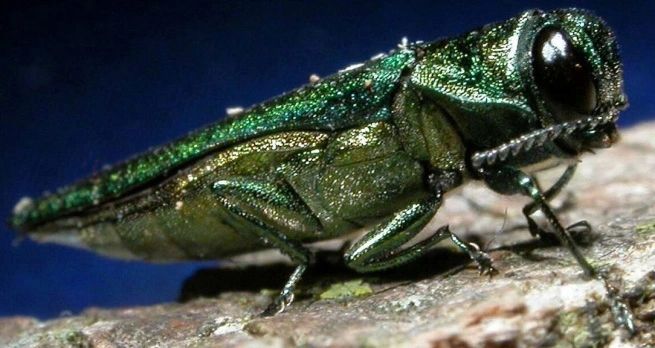The Emerald Ash Borer
-
Do you or your neighbors have ash trees on your properties?
-
Have the ash trees in your neighborhood been affected by the Ash Borer yet?
-

What to Look for:
Signs and Symptoms
Infestations of the Emerald Ash Borer can be difficult to detect unless you know what to look for.
Symptomatic trees display thinning and dieback of the upper one-third of the crown as shown in this example:

Directly below the lowest point of infestation, root and stem suckers develop. These suckers can occur at the bottom or anywhere on the tree and mark where the infectation point begins.

Tissue produced by the host tree in response to larvae tunneling may cause vertical splits on the trunk. Removal of the bark in these areas reveals the larvae tunnels. A definitive sign of this exotic pest is the D-shaped adult emergence holes. Unfortunately, signs of early infestations are limited to the upper part of the tree making it difficult to detect in the early stages. Tree deaths usually occur within 3 years of initial attack.

What You Can Do:
First, you must identify the Ash Trees on your property and determine if they are affected by the Ash Borer yet. If the tree is not showing any signs of infestation or it is in the early stages and you would like to save the tree, there are chemical treatments that can be administered by an arborist. If the infested tree has progressed beyond the point where it can be saved or you would prefer not to treat and save the tree, you should have the tree and the stump removed as soon as possible to help slow down the spread of the borer in your neighborhood.
How We Can Help:
While Metallo Stump Removal specializes in the grinding of tree stumps, we have been in the tree care industry over 15 years. We work closely with some very reputable aborists and tree care companies. If you are looking for a general tree consultation, treatment options or a complete removal, please give us a call. We are more than happy to assist you with a recommendation.
For more information regarding the Emerald Ash Borer, please visit the Illinois Department of Agriculture website http://www.agr.state.il.us/eab/

